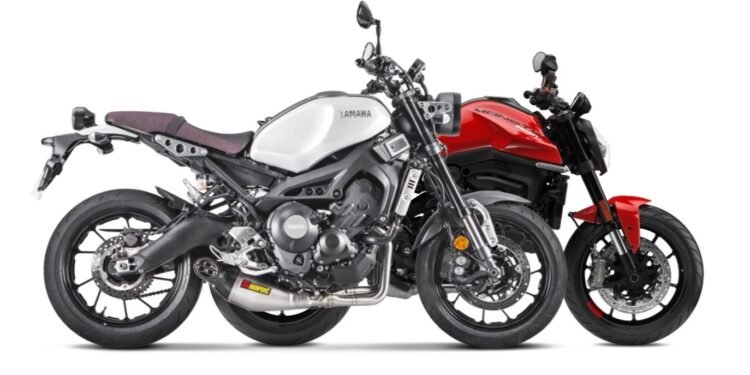Acceleration battle between the Ducati Monster and Yamaha XSR900
The Ducati Monster and Yamaha XSR 900 have been tested recently by Motorstatz albeit in different countries. Both machines occupy the same class and are equipped with similarly sized engine capacities. Both produce comparable power outputs.
These motorcycles, although similar, are also very different.
From their looks to their sound and the riding experience on the road. Each motorcycle delivers a unique feeling and experience that is likely to cater to different tastes.

The Ducati Monster is a hugely popular machine and has been with us for 30 years in an almost countless number of variants.
The most current model here is a little less Italian-looking and perhaps more Japanese-looking than I’d like. But it is still an attractive looking motorcycle.
Yamaha’s XSR 900 has also been with us for a while now, but its time on this earth makes it a new kid on the block compared to Ducati’s Monster.
The XSR900 is a prettier version of the Yamaha MT-09. It’s arguably little more ‘designer-looking’, especially with the retro 80s paint job and stripes but with a wild 80s character just like its sibling.
It’s quite European-looking.
You may be looking at these motorcycles and interested in how they stack up against one another from their motors and straight-line performance.
Because whether we admit to ourselves or not, it matters.

If we look at both machines, what are the main differences?
Their engine sizes are similar so they’re in the same weight class if this were a fight, which it is.
The Ducati Monster engine configuration is not a surprise boasting a 937 cc L-Twin while the Yamaha XSR 900 has an arguably more exotic Inline three-cylinder motor.
L-wins have become like new inline fours, they’re hardly exotic any longer. Actually, I’ll take that back, parallel twins are the new inline fours. They’re everywhere now.
I would argue that the XSR900 has The Ducati Monster beat out on the exotic front for sure.
The Yamaha XSR900 engine gives away a little capacity to the Monster coming in at 847 cc……Perhaps cutting weight before the fight huh?
Ducati claims 111 horsepower and 69 ft/lb at the crank. These are not mind-blowing numbers and Ducati could have given us a little more power without sacrificing anything.
Either way in a world full of speed cameras these numbers are good and fall in line with most upper-middleweight machines.
Despite giving away almost 100 cc, the Yamaha XSR 900 has a claimed 115 horsepower and almost the same peak torque of the Monster with 68 ft//lb.
Nothing wild considering a Triumph T595 back in the mid-90s with its chonky 955 cc produced a claimed 128 horsepower at the crank! Its naked counterpart the T509 had 108 horsepower from 885 cc.
Does not sound like we made much progress in 20 years?
Anyway, Yamaha’s XSR 900 produces a little more power than the Ducati Monster, despite being a smaller-capacity engine.
This slight power advantage is predominantly down to the XSR 900 boasting an extra cylinder and revving higher than the Ducati Monster!
All else being equal between the two machines, if one revs higher it will produce more power!
The Ducati Monster is Lighter than the XSR900
Yes, the Ducati Monster is lighter, but the difference is not significant enough for you to notice or for it to really matter that much.
Wet weights for both come in at 193 kg for the Yamaha XSR 900 and 188 kg for the Ducati Monster.
In the quest for straight-line performance, every kg saved does make an objective difference in acceleration and braking performance.
This is largely because motorcycles produce less power and are as accelerative as they are due to their lack of weight compared to cars.
A 5 kg weight saving for a motorcycle could be equivalent to a 30-50 kg weight saving for a car. (Depending on its actual weight)
So while it may not be noticed so much by the rider, outright and roll-on acceleration between two machines producing the same power, the lighter one will be a fraction faster even if 5 kg is the difference.
In the real world, this will be harder to notice due to rider skill and consistency.
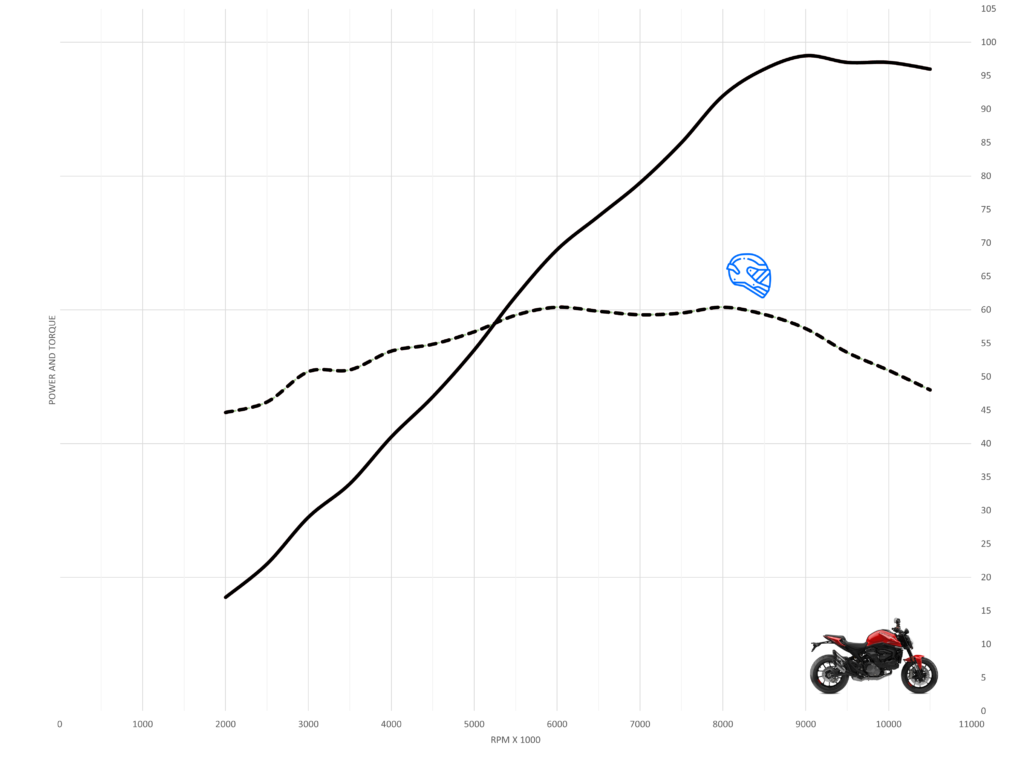
On the Dyno, the Ducati Monster produces a solid 97 horsepower at 9100 rpm and 61 ft/lb of torque at 6000 rpm.
Peak power is a little down on other Monster examples and the Ducati Supersport that shares the same engine.
Dynos operators can often use different correction factors which will yield higher or lower results.
There can also be slight variations in machines. Both of these factors among many others account for the differences you see in terms of peak numbers.
The power and torque curve is typical of this engine type and Monsters’ of the past.
I’ll add that the Ducati has done a great job beefing up power and torque below 5000 rpm to smoothen out that kick-in torque often seen from sportier twin engines as they come on cam.
Acceleration build-up below and up to 6000 rpm is much more linear.
Despite the absence of a kick, that constant linear build of torque does ensure that the Ducati Monster engine feels eager and willing to rev.
This ensures the engine is a pleasure to use because it always feels enthusiastic and has no noticeable dips. Just a linear build-up of power and torque.
Unlike many big twins, the Ducati Monster is very tractable and smooth considering it has two large pistons.
You can run higher gears and pull from as low as 3000 rpm without too many vibrations but the sweet spot is around 3500 rpm and upward.
From then on it is almost as smooth as a four-cylinder. Long gone are the days of rattling Ducatis.
| Power/Torque | Ducati Monster Power & Torque |
| Power | 96hp @ 9,100 rpm |
| Torque | 61 ft/lb @ 6000 rpm |
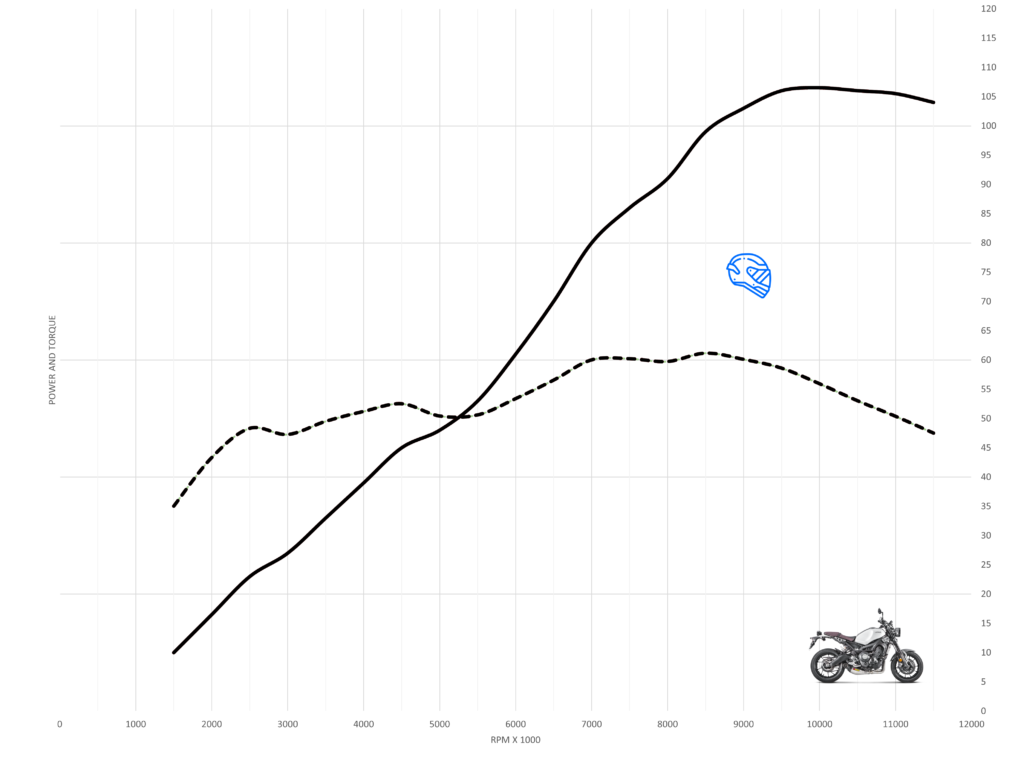
The Yamaha XSR900 engine is the same as the MT-09 engine as you all likely know already.
Despite its modest peak power claims, It is arguably one of the best engines out there and sounds fantastic too.
As already mentioned the XSR900 packs 847 cc divided in the three cylinders in-line.
Those claimed numbers do not sound all that impressive for an 847 cc engine but the on-paper numbers do this peach of an engine very little justice.
Our Yamaha XSR 900 was not stock and had a very loud SC-Project exhaust but had a not-so-tuned’ ECU Flash.
So the peak of 106 horsepower at around 9,800 rpm and 61 ft/lb at 8,500 rpm is comparable to a stock machine, albeit a little fluffy fuelling low down but goes hard.
| Power/Torque | Yamaha XSR900 Power & Torque |
| Power | 106hp @ 9,800 rpm |
| Torque | 61 ft/lb @ 8,500 rpm |
Which engine is stronger – the Ducati Monster or XSR900?
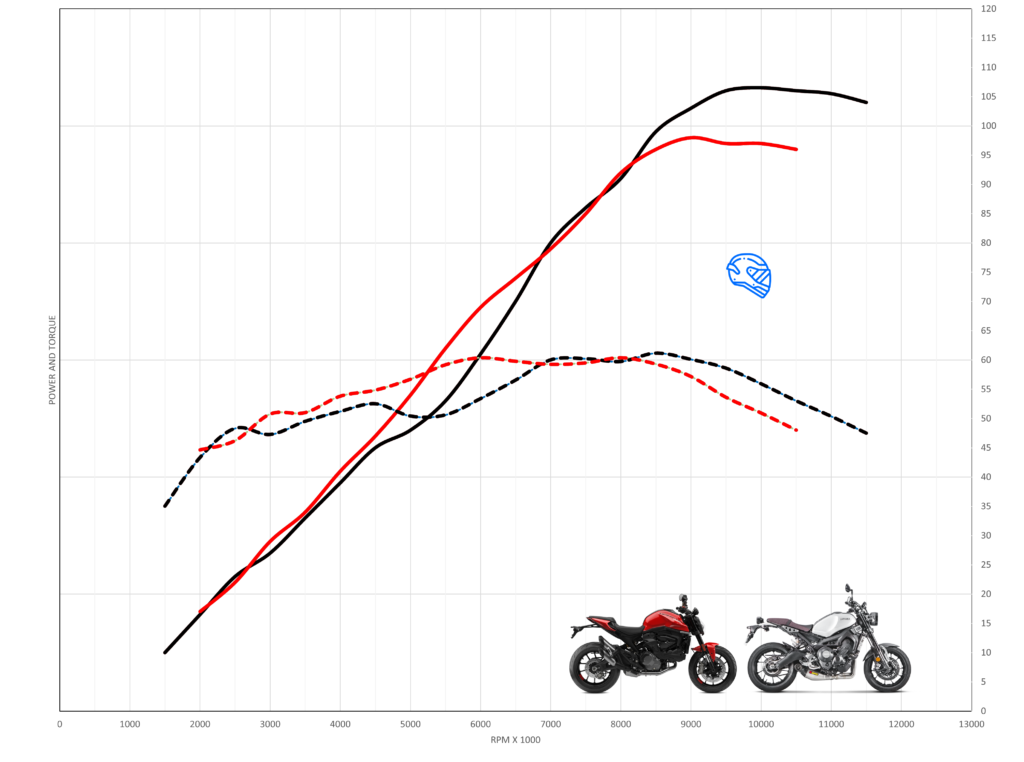
Both engine outputs match up well with broadly similar power and torque outputs across the rpm range. The Yamaha XSR900 has an edge with a nine-horsepower peak advantage over the Italian machine.
As for torque, there is a 1ft/lb advantage that goes to the XSR900 too so not much in it.
In terms of outright power, It doesn’t look too good for the Ducati Monster, but if we look closer, the Monster is a stronger engine most of the time.
Especially in the mod par of the rev range.
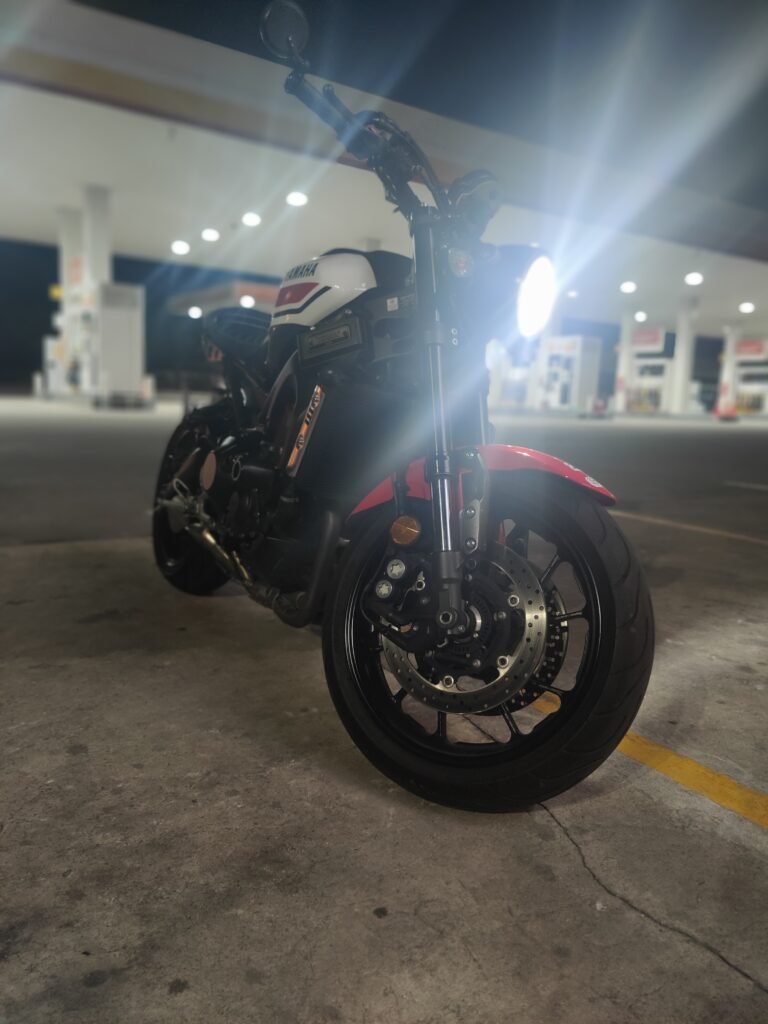
From as little as 2000 rpm the Monster has an advantage, then from 4500 rpm to 7000 rpm the Ducati Monster engine is considerably stronger than the XSR 900.
This part of the rpm range is exactly where you need as much power and torque as possible. This is true because that’s the part of the rev range you’ll find yourself using most of the time.
So the more you have, it’s just better. You can never have enough.

To hit home the point, the Monster produces 10 horsepower and 10 ft/lb more than the ZSR900 at 5500 rpm.
In fairness to the Yamaha XSR900, it does give away 90 cc to the Ducati, which is more than 10% engine capacity. So it is no surprise that it will produce a little less power and torque throughout the rpm range.
Despite the capacity disadvantage, from 7000 rpm upward, the XSR900 exceeds expectations matches and beats the Monster for power and torque.
Then from a little over 8000 rpm, the XSR900 continues to produce more power and torque than the Monster where it ends up with that earlier mentioned 9 horsepower advantage.
Yamaha’s extra cylinder helping it rev higher is a primary reason why it produces more power than the Ducati Monster.
It may come at a slight cost; as evident by that dip in torque is right in the midrange. But that’s more likely down to emissions and noise regulations or a sucky tune as per our example.
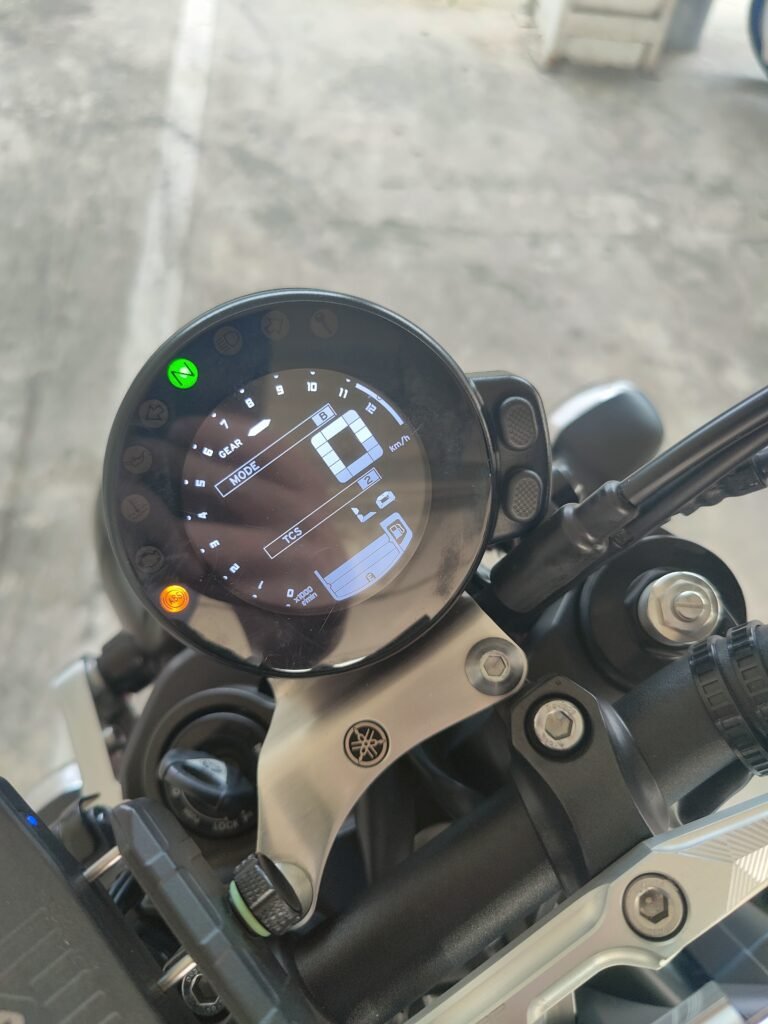
It’s not like Ducati couldn’t produce a Monster that could match or exceed the power of the XSR900, but no doubt you’d had a very different power and torque delivery, and perhaps not in spirit with a Monster.
Take a look at the V2 vs the Supersport. Two engines with very similar configurations and capacities but very different results on the dyno.
Between the XSR900 and Ducati Monster, It is hard to say which engine is better from a performance perspective.
The Monster engine is more consistent in terms of the availability of its power/torque.
It does not need revving as hard and is a little less gear-dependent.
The Yamaha XSR900 engine on the other hand is faster, but requires a little more thrashing and prefers to be above 7000 rpm.
The XSR900 Engine is the more exciting that’s for sure.
Speed in gears at 5000 rpm
| Speed at 5000 rpm | Monster | XSR900 |
| 1st | 28.2 mph | 29.3 mph |
| 2nd | 39.5 mph | 39 mph |
| 3rd | 49.7 mph | 48.2 mph |
| 4th | 58.9 mph | 56.5 mph |
| 5th | 66.7 mph | 65.5 mph |
| 6th | 72.7 mph | 75.2 mph |
Ducati’s Monster is geared a little lower than the XSR900.
This is a little surprising because higher-revving motorcycles of a similar capacity to competitors tend to run lower gearing thanks to their ability to rev higher.
The Monster is geared perfectly while Yamaha could have gotten away with gearing the XSR900 lower than it comes as stock.
For example; in top gear, if the Yamaha XSR900 could kiss its rpm limiter it would be north of 160 mph real speed and perhaps 180 mph indicated. (Yes motorcycle Speedos are bad liars)

Due to the Ducati Monster’s lower gearing, it makes fantastic use of its punchier engine!
If we observe the in-gear thrust/acceleration curve, the Monster is stronger across the majority of the speed range in all gears.
This would be the same story if the gearing of both machines were the same, but it’s not, the gearing of the Monster is lower which puts more emphasis on its punchier engine and gives it a point and squirt advantage.
Yamaha’s extra peak power doesn’t see the light of day against the Monster unless you’re chasing the very top of each gear.
For example, at 70 mph in top gear, the XSR900 needs fifth gear to produce the same thrust/acceleration as the Monster.
If you and your mate were on each motorcycle cruising highway speeds in sixth gear, whoever was riding the XSR900 would be dusted if you both rolled on.
This is also true for most realistic riding situations, the monster will jump out ahead.
Luckily for XSR900 fanboys, one can drop some teeth at the front or add some teeth to the rear sprocket and make the XSR900 even wilder.
Doing this can work well because the XSR is already a little over-geared as stock so it will not feel under-geared and buzzy.
Doing the same to the Monster, while fun would make it a little too buzzy (IMO) for a twin which may not be to everyone’s taste.
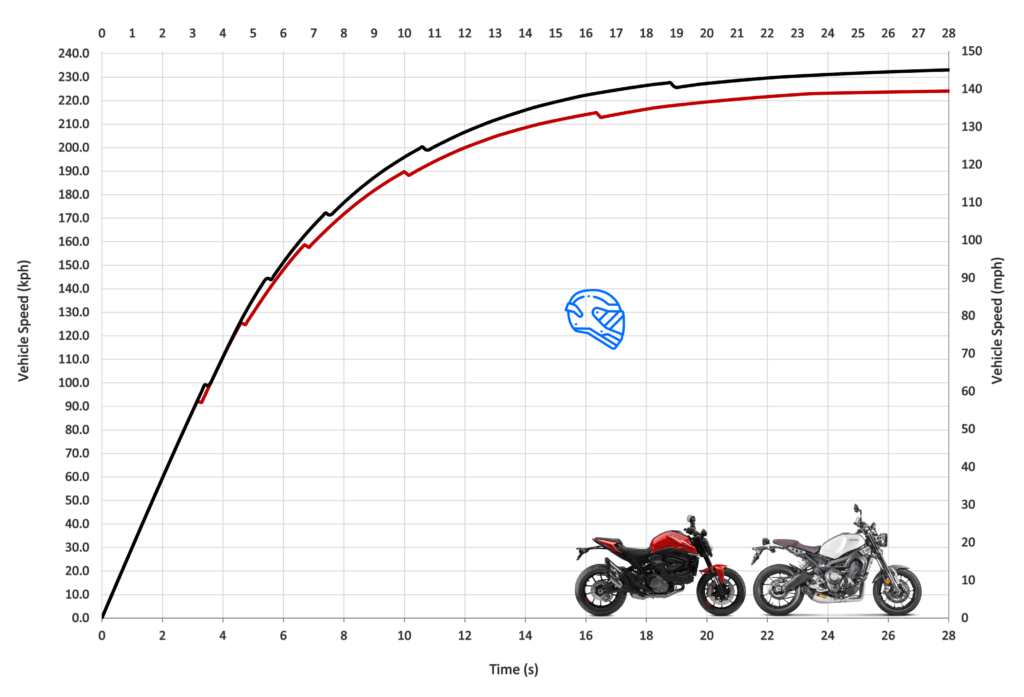
In a straight line, the Yamaha XSR900 is a faster motorcycle. It is not by much, but It is that extra 9 horsepower up top that makes the difference in the end.
Their 0-60 mph are very similar and it will mostly come down to rider skill if you’re launching from the lights.
Both machines are wheelie-prone but the Monster is less consistent and overall slower to 60 mph because it can’t quite hit 60 mph in first gear. Instead and unlike the Yamaha it requires a gear change.
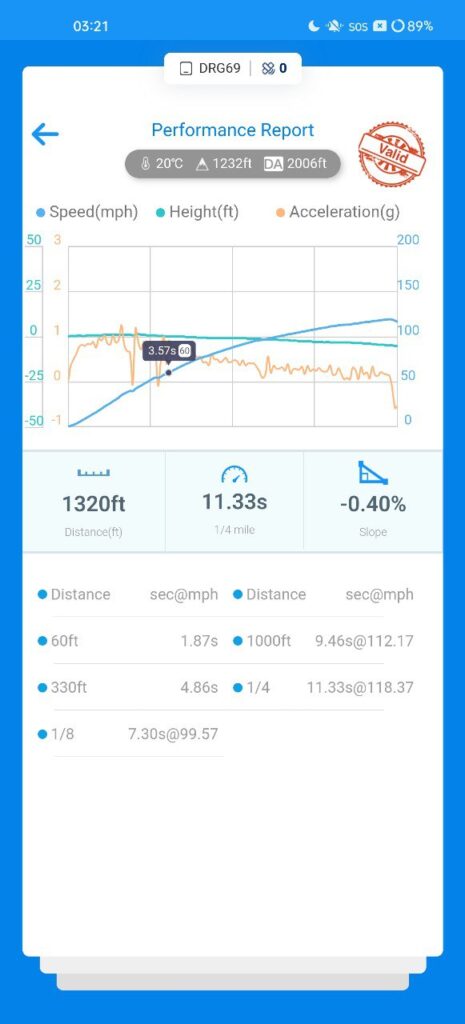
When all is said and done the XSR900 is around two-tenths quicker to 60 mph achieving a time of 3.26 seconds compared to the Ducati Monsters 3.44 seconds from 0-60 mph. If the race was from 0-50 mph the monster would have it most of the time because it is a little more consistent and and less likely to bog.
It’s from above 60 mph where skill is a diminishing factor and the Yamaha XSR900 can extend its advantage where it is almost a second faster to 100 mph with a time of 6.48 seconds versus 7.46 seconds.
Again it’s the Ducati Monsters gearing that makes it a little inconsistent to 100 mph as you have to kiss the limiter because 100 mph comes up literally at the rev limiter.

So to avoid hurting the quarter mile time it is wise to sacrifice the 0-100 mph time to avoid bouncing her off the limiter.
The Yamaha on the other hand has more than enough legs in third gear to hit close to 110 mph plus.
Through the quarter mile, it is close between both machines. The Yamaha XSR900 is a little faster with a time of 11.15 seconds and a terminal speed of 125.5 mph.
The Ducati Monster is a few bike lengths back at 11.33 with a terminal speed of 118 mph. The monster did hit a higher terminal speed of 121 mph but with a slightly slower time of 11.36 seconds.
In ideal conditions, both motorcycles are capable of sub eleven second times but the surface that both machines encounter was a little slippery.
Both machines are closely matched on acceleration but that extra 9 horsepower that the Yamaha has ensures that it will slowly walk away from the Monster when push comes to shove.
This is the same for top speed too, with the Yamaha XSR900 clocking 144 mph and the Ducati Monster 140.9 mph.
With the extra 9 horsepower the Yamaha has, you’d think there would be a greater difference in top speed between both machines.
The monster does have a smaller front end and as a result, could be a little more slippery! This does make a huge difference when speeds get high.
| Speed | XSR900 | Ducati Monster |
| 0-10 mph | 0.36 | 0.52 |
| 0-20 mph | 1.21 | 1.02 |
| 0-30 mph | 1.62 | 1.49 |
| 0-40 mph | 2.17 | 2..01 |
| 0-50 mph | 2.69 | 2.53 |
| 0-60 mph | 3.26 | 3.44 |
| 0-70 mph | 4.02 | 4.1 |
| 0-80 mph | 4.71 | 5.08 |
| 0-90 mph | 5.63 | 6.06 |
| 0-100 mph | 6.48 | 7.46 |
| 0-110 mph | 7.61 | 9.05 |
| 0-120 mph | 9.11 | 11.35 |
| 0-130 mph | 12.37 | 14.9 |
| 0-140 mph | 17.15 | 27 |
| 60-130 mph | 9 | / |
| SS/QM | 11.15 @ 125.5 mph | 11.33 @ 118 mph – 11.36 @ 121 mph |
| SS/KM | 20.96 @ 142 mph | 21.60 @ 139 mph |
| Top Speed | 144 mph | 140.9 mph |



